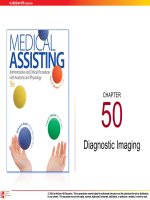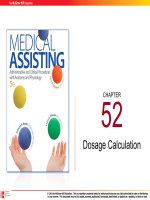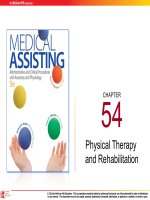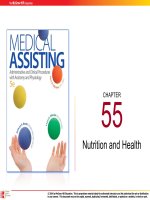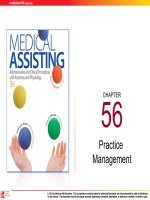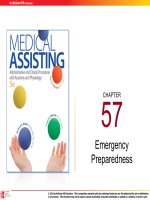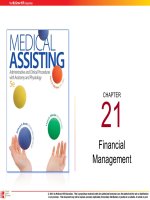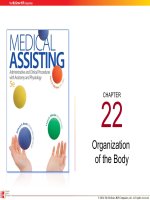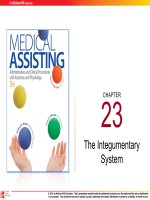Medical assisting Administrative and clinical procedures (5e) Chapter 6 Basic safety and infection control
Bạn đang xem bản rút gọn của tài liệu. Xem và tải ngay bản đầy đủ của tài liệu tại đây (1.21 MB, 63 trang )
CHAPTER
6
Basic Safety and
Infection Control
6-2
Learning Outcomes
6.1
Describe the components of a medical office
safety plan.
6.2
Identify OSHA’s role in protecting healthcare
workers.
6.3 Describe basic safety precautions you
should take to reduce electrical hazards.
6.4 Illustrate the necessary steps in a
comprehensive fire safety plan.
6-3
Learning Outcomes (cont.)
6.5
Summarize proper methods for handling and
storing chemicals used in a medical office.
6.6
Explain the principles of good ergonomic
practice and physical safety in the medical
office.
6.7
Illustrate the cycle of infection and how to
break it.
6-4
Learning Outcomes
6.8 Summarize the Bloodborne Pathogens
Standard and Universal Precautions as described
in the rules and regulations of the Occupational
Safety and Health
Administration (OSHA).
6.9 Describe methods of infection control
including those preventing healthcareassociated infections.
6.10 Describe Centers for Disease Control and
Prevention (CDC) requirements for reporting
cases of infectious disease.
6-5
Introduction
• Accidents can occur in healthcare settings
• Remove or correct hazards
– Physical
– Chemical
– Biohazardous
• Removal or correction of hazards is integral to risk
management
6-6
Medical Office Safety Plan
• Minimize risk
• Establish a safety plan
• Education about potential dangers facilitates the removal
or correction of these hazards
6-7
Medical Office Safety Plan (cont.)
• Comprehensive written safety plan
• Easily accessible
• Updated annually
• Know and follow the plan’s policies and procedures
6-8
Apply Your Knowledge
Why is it important to have a safety plan in a
medical office and what should the plan cover?
ANSWER: It is important to have a safety plan to help
minimize risk and make everyone aware of potential
hazards. A safety plan should contain:
•OSHA Hazard Communication
•Electrical and fire safety
•Emergency action plan
•Chemical safety
•Blood borne pathogen exposure
•Personal protective equipment
•Needlestick prevention
6-9
Occupational Safety and Health
Administration
• Employee safety
• Specific standard vs. General Duty Clause
• Enforces guidelines established by the Centers for
Disease Control and Prevention (CDC)
6-10
OSHA Hazard Communication
• Biohazard labels
• Warning signs
• Material Safety Data
Sheets (MSDSs)
• Hazard labels
6-11
OSHA
• Final rule
– Standardize
• Labeling
• Safety information
– Right to understand
– Changes
• Hazard
classification
• Labels
• MSDSs
6-12
Apply Your Knowledge
Why is it important for hazardous materials be
correctly labeled?
ANSWER: So employees can take measures to
protect themselves against harm.
6-13
Electrical Safety
• Know location of power shutoffs
• Avoid using extension cords
• Observe for frayed electrical wires
• Dry hands before working with electrical devices
• Do not position electrical devices near sources
of water
6-14
Apply Your Knowledge
List three electrical safeguards to practice in the
healthcare setting?
ANSWER:
•Avoid using extension cords. Tape extension cords to the
floor to avoid tripping.
•Repair or replace equipment that has a broken or frayed
cord.
•Dry your hands before working with electrical devices.
•Do not position electrical devices near sinks, faucets, or
other sources of water.
6-15
Fire Safety
• Many potential hazards in a
medical office
• Fire Prevention
– Hazards in the exam
room
– Office laboratory ~ open
flame
6-16
In Case of Fire (cont.)
• Using safety equipment
– Fire extinguisher – “PASS”
system
– Fire blanket
6-17
Emergency Action Plans and Drills
• Responsibility
– Reporting fire
– Overseeing
evacuation
• Building evacuation
routes
– Current location
– Nearest exit
6-18
Emergency Action Plans and Drills (cont.)
• Evacuation Procedure
– Ensure patients and staff are evacuated
– Check that everyone has left
– Take MSDS book
– Assembly area
– Emergency action plan drills
– Local emergency contacts
6-19
Apply Your Knowledge
Once at the assembly area after an evacuation
how would you account for employees and
patients?
ANSWER: Conduct a roll call of all employees. You
can use the check-in roster to account for patients.
6-20
Chemical Safety
• Proper handling and storage
• MSDS
• General precautions
• Eye wash station
6-21
Chemical Safety (cont.)
• Do not hold under
nose
• Use fume hood or
personal ventilation
device
• Only combine
chemicals as required
• No mouth pipetting
• Add acid to other
substances
• Clean up spills
properly
6-22
Apply Your Knowledge
What are the precautions you should take
when working with hazardous substances?
ANSWER:
•Store below eye level
•Wear protective gear
•Carry with both hands
•Properly ventilated
6-23
Ergonomics and Physical Safety
• Ergonomics
• Maintain a healthy
and safe posture
• Do not over reach
• Lift properly
6-24
Ergonomics
• Transferring a patient
– Lift with knees
– Ask for assistance
– Use transfer device
• Adjust seat
• Take frequent breaks from the
computer
6-25
Physical Safety
• Walk, do not run, in the office.
• Wipe up spills immediately
• Clear the floor of dropped objects
• Be sure there are no snags or tears in the carpet
• Destroy and dispose of medications that are
dropped on the floor
